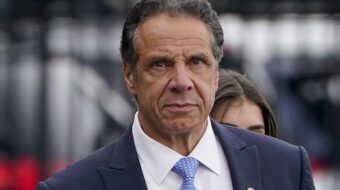NEW HAVEN, Conn. — The big success of the Elm City Residents Card, which has received an overwhelmingly positive response here, has also become a model for other cities. The history of the new ID card is a history filled with the struggle for immigrant rights and workers’ rights.
Some background
After the tragedy of Sept. 11, 2001, and the increase in racial profiling, the Latino immigrant community in New Haven came together at the New Haven People’s Center where they helped found Unidad Latina en Accion (ULA).
The biggest concern for everyone was the inability to get a driver’s license for travel to work and for shopping, medical appointments and other necessities.
A bill was introduced into the Legislature to allow any resident of Connecticut, regardless of immigration status, to receive a driver’s license if they passed the test. Despite many hearings, petitions and knocking on doors, the bill was defeated.
After this great disappointment, the question was placed at a ULA meeting: “What else can we do? We’re not going to give up.” The answer came: “Let’s work together to get the city to issue ID cards in New Haven.” This would improve the lives of immigrants who, for lack of an ID, could not get bank accounts or who were reluctant to report crimes to the police for fear of being harassed or deported.
Such a card, its supporters pointed out, would benefit the entire community.
Taking action
The City of New Haven Peace Commission proposed that the New Haven Board of Aldermen hold a series of public hearings to learn about the precarious situation immigrants face every day. Junta for Progressive Action, a nonprofit organization in the Fair Haven neighborhood, which includes a large immigrant population, working with ULA, presented an action program, including the city ID.
But what made this program so successful?
Without the organized voice of the immigrant community, it could not have been achieved. ULA spent many hours knocking on doors, phone banking, talking on the street and distributing fliers to build the base for this effort.
During this same period, ULA and Junta convened a huge meeting at St. Rosa de Lima Church with Police Chief Francisco Ortiz and his staff. The proposal for the ID program and relations with the police were discussed. In the coming months, this resulted in a police order that immigration status should not be requested during other civil matters. Mayor John DeStefano Jr. publicly endorsed the ID program.
In the meantime, the entire community became engaged.
Forums were organized by ULA and Junta in which students from the Yale Law School participated as legal advisers. Public pressure was placed on the mayor to speed up the process for the ID, emphasizing that this card would not just be for immigrants, but for all New Haven residents.
In December 2006, after many months of waiting, ULA organized a press conference at the mayor’s office where they presented him with a giant Christmas card wish list. The top wish was, “Mr. Mayor, the immigrant community needs our New Haven Resident City ID.” DeStefano was willing to hear the concerns and said he was working on it.
To lay the groundwork for the card, the city sought legal advice and raised private funds to cover the costs of the entire project.
In the spring of 2007, a subcommittee of the Board of Aldermen held a meeting to discuss the viability of the ID. The committee members agreed to bring the ID to the full board with a recommendation to adopt.
A big ‘yes’ vote, followed by a raid
On June 4, with aldermanic chambers filled beyond capacity, the final vote was 25-1 to enact the ID program. People throughout New Haven were celebrating.
But 36 hours later, Immigration Control Enforcement (ICE) came to New Haven in the early morning hours, snatching 34 people in front of their children, leaving the families terrorized.
Within hours, a meeting of community leaders was held in the office of Kica Matos, director of the city’s community services and former director of Junta, who played a leadership role in developing the ID. Arrangements were made to aid the children and family members of those detained and to raise bail funds.
In response to the ICE raid, ULA called an emergency meeting at the New Haven People’s Center that was attended by clergy, union and community leaders and members of the immigrant community. Four actions were planned.
First, a press conference was held with Lila Downs, a popular Mexican American singer who was performing at the International Festival of Arts and Ideas.
Second, a solidarity demonstration was held at the federal building in Hartford, where the bond hearing took place for many of those detained by ICE.
Third, a team organized by ULA served as visible guardians in the Fair Haven neighborhood where the raid took place, wearing signs and distributing cards telling people what to do if they were contacted by ICE. This was important to stop rumors and allay fears of another raid.
Fourth, a remarkable march of over 1,000 people was organized within a week. The marchers gathered in the Fair Haven neighborhood. Overcoming great fear, the immigrant community marched and was joined by union members from many states, clergy with their congregations, the mayor and other elected officials and activists who marched two miles in the rain, finishing with a rally in City Hall.
John Wilhelm, president of the hospitality division of the Unite Here union, joined the march in solidarity along with members of his union from the East Coast. Four years earlier, a group of immigrant workers showed solidarity with Unite Here when they refused to break the strike of workers at Yale University.
The card takes off
A political climate was created to defend the New Haven Residents Card. The first ID cards were issued on July 24, with full coverage by the national media. For two weeks, the lines filled City Hall. In the first five weeks, 3,348 cards were issued despite harassment by a small out-of-town anti-immigrant group who picketed City Hall for the first two days.
The New Haven Residents Card is a multipurpose card available to all residents regardless of age or immigration status.
Some banks have already announced they will accept the ID card for opening accounts. Parents are getting the card for their children for safety in case they get lost. Elderly residents without a driver’s license are signing up for the card.
Cards are issued at the Office of Residents in City Hall on weekdays from 9 a.m. to 2 p.m. to those who can provide proof of identity (passport, consular ID, driver’s license) and two proofs of residence (rent receipt, utility bill, pay stub).
The cost is $10 for adults and $5 for children and seniors. In addition to serving as a photo ID, the card includes a library card, access to public parks and the city dump, and can serve as a debit card for parking meters and goods and services at 150 participating stores.
Complete information about the ID card is available on the City of New Haven web site, www.cityofnewhaven.com. For information about Unidad Latina en Accion, call (203) 606-3484 or (203) 479-2959.
Fátima Rojas is a leader of Unidad Latina en Accion. Joelle Fishman is an activist at the New Haven People’s Center and chairs the Connecticut Communist Party USA.









